Overview of Align and Prompt: Video-and-Language Pre-training with Entity Prompts
This essay provides a detailed investigation of the paper "Align and Prompt: Video-and-Language Pre-training with Entity Prompts" by Dongxu Li et al., which introduces a novel approach to video-and-language pre-training, dubbed AlPro. The paper aims to address specific challenges faced in cross-modal interactions and fine-grained alignment between videos and texts.
Key Contributions
The paper makes noteworthy strides in the domain of video-and-language pre-training by introducing several novel aspects:
- Sparsely-Sampled Video Frames: AlPro innovatively applies a sparse sampling strategy, enabling efficient training without the necessity for large-scale object detection, which often involves high computation costs and limited vocabularies.
- Video-Text Contrastive (VTC) Loss: This approach introduces the VTC loss at the unimodal level to address misalignments and bolster cross-modal representation learning. This contrasts with other approaches that limit their modeling to within-modal interactions.
- Prompting Entity Modeling (PEM): PEM is employed as a visually-grounded pre-training task that leverages an entity prompter to facilitate region-entity alignment without relying on off-the-shelf object detectors.
- State-of-the-art Performance: AlPro demonstrates substantial performance improvements in text-video retrieval and video question answering (videoQA) tasks, surpassing prior methods by a notable margin.
Implications of Findings
The implications of this research are manifold, both practically and theoretically. By effectively minimizing computation costs typically associated with traditional video feature extraction methods, AlPro provides a scalable solution that could significantly impact real-world applications that integrate video and language data, such as content recommendation systems, automated video tagging, and more nuanced systems like video-based AI assistants.
Moreover, theoretically, this research highlights an important shift in the perspective on unimodal versus multimodal alignment, directing attention toward designing pre-training models that circumvent domain mismatches by leveraging contrastive losses.
Numerical Insights and Achievements
The AlPro framework achieved state-of-the-art results in both finetuning and zero-shot evaluation settings. For instance, AlPro improved recall scores in text-video retrieval tasks, achieving a 3.0% lift in recall on MSRVTT, and a 5.4% improvement in DiDeMo datasets. Additionally, in videoQA tasks like MSVD-QA and MSRVTT-QA, the model achieved respective lifts of 2.8% and 3.4% in accuracy, underscoring its capacity for nuanced, cross-modal understanding.
Future Speculations
The framework introduced in this paper potentially lays foundational work for developing more sophisticated models that require fewer annotations and are less computation-intensive. Future research could expand upon this by exploring automated refinement of the entity prompting process, thus potentially enhancing cross-modal learning capabilities further. Additionally, integrating temporal dynamics into prompting and aligning this with advancements in LLMs, particularly as they scale in complexity and understanding, could leverage AlPro’s architecture in unexamined domains.
Conclusion
Dongxu Li et al.’s paper presents a rigorously defined and well-validated framework for video-and-language pre-training. By enhancing the alignment between video and language modalities and mitigating computation overheads, AlPro marks a significant contribution to the field. The introduction of VTC and PEM as losses in the pre-training phase could inspired subsequent research that continues to refine how video and textual data interact to broaden the scope and applicability of multimodal machine learning models.
